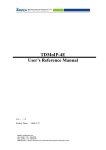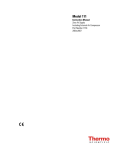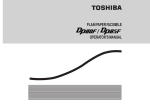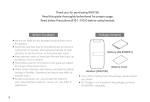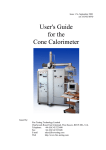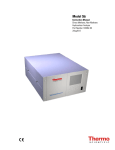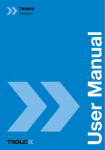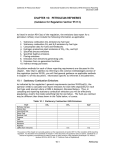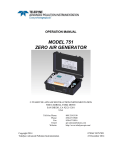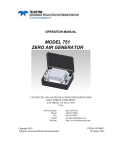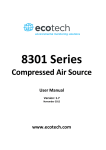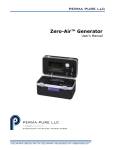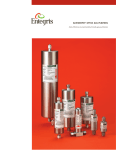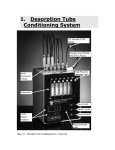Download Model 1160 - User Manual
Transcript
Model 1160 Instruction Manual Zero Air Supply Part Number 18665 2Jun2010 The 220V option complies with 89/336/EEC directive for electromagnetic compatibility. © 2007 Thermo Fisher Scientific Inc. All rights reserved. Specifications, terms and pricing are subject to change. Not all products are available in all countries. Please consult your local sales representative for details. Thermo Fisher Scientific Air Quality Instruments 27 Forge Parkway Franklin, MA 02038 1-508-520-0430 www.thermo.com/aqi WEEE Compliance This product is required to comply with the European Union’s Waste Electrical & Electronic Equipment (WEEE) Directive 2002/96/EC. It is marked with the following symbol: Thermo Fisher Scientific has contracted with one or more recycling/disposal companies in each EU Member State, and this product should be disposed of or recycled through them. Further information on Thermo Fisher Scientific’s compliance with these Directives, the recyclers in your country, and information on Thermo Fisher Scientific products which may assist the detection of substances subject to the RoHS Directive are available at: www.thermo.com/WEEERoHS. Thermo Fisher Scientific WEEE Compliance TABLE OF CONTENTS CHAPTER 1 INTRODUCTION .........................................................................1-1 Basic Platform.................................................................................................................. 1-1 Add-Ons........................................................................................................................... 1-2 Performance Specifications ............................................................................................. 1-5 CHAPTER 2 INSTALLATION ..........................................................................2-1 Lifting .............................................................................................................................. 2-1 Unpacking ........................................................................................................................ 2-1 Assembly.......................................................................................................................... 2-2 Input/Output Functions .................................................................................................... 2-3 Scrubber Installation ........................................................................................................ 2-4 CHAPTER 3 OPERATION ...............................................................................3-1 Front Panel Display and Controls.................................................................................... 3-1 Pressure ................................................................................................................ 3-2 Converter Temperature ........................................................................................ 3-2 Status LEDs ......................................................................................................... 3-2 Converter Ready ...................................................................................... 3-2 Standby .................................................................................................... 3-2 Service Alarm .......................................................................................... 3-2 Mode Selection .................................................................................................... 3-3 Converter Temperature ........................................................................................ 3-5 Power-Up Sequence......................................................................................................... 3-6 CHAPTER 4 MAINTENANCE ..........................................................................4-1 Spare Parts ....................................................................................................................... 4-1 Scrubbers ......................................................................................................................... 4-3 Compressor ...................................................................................................................... 4-4 Fan Filter.......................................................................................................................... 4-4 Fuse Replacement ............................................................................................................ 4-4 Service Alarm Battery ..................................................................................................... 4-4 Service Locations............................................................................................................. 4-5 v APPENDIX A WARRANTY ............................................................................. A-1 APPENDIX B PUMP/COMPRESSOR MAINTENANCE.................................. B-1 APPENDIX C SCHEMATICS .......................................................................... C-1 Power Supply Board ........................................................................................................C-2 Display Board ..................................................................................................................C-3 Rear Connector Interface .................................................................................................C-4 Instrument AC Power, 120 VAC, 50/60 Hz ....................................................................C-5 Instrument AC Power, 220 VAC, 50 Hz .........................................................................C-6 Instrument AC Power, 240 VAC, 60 Hz .........................................................................C-7 Instrument AC Power, 100 VAC, 50/60 Hz ....................................................................C-8 vi LIST OF ILLUSTRATIONS Figure Page 1-1 1-2 Model 1160 Components..................................................................................... 1-3 Model 1160 Flow Schematic ............................................................................... 1-4 2-1 2-2 2-3 2-4 Model 1160 Rear Panel........................................................................................ 2-2 Pin Out of Rear Panel Terminal Strip .................................................................. 2-3 Scrubber Base and Top Plates ............................................................................. 2-5 Scrubber Assembly Components......................................................................... 2-6 3-1 3-2 3-3 Front Panel Display ............................................................................................. 3-1 Display Board ...................................................................................................... 3-4 Power Board Component Footprint ..................................................................... 3-5 4-1 Scrubber Parts List............................................................................................... 4-2 vii LIST OF TABLES Table Page 1-1 Pollutant, Removal Method, and Removal Component ...................................... 1-1 3-1 Mode Selections................................................................................................... 3-3 4-1 Recommended Spare Parts .................................................................................. 4-1 ix CHAPTER 1 INTRODUCTION Thermo Scientific’s Model 1160 Zero Air Supply converts ambient air to pollutant-free air. Table 1-1 describes the pollutants that can be removed, the method of removal, and the removal component. Table 1-1. Pollutant, Removal Method, and Removal Component Pollutant/Contaminant Method Component Water Condensation Adsorbent desiccant Membrane permeation Absorption Cooling loop/coalescing filters Regenerative dryer Membrane dryer Drierite scrubber Oxides of Nitrogen (NOx) Adsorption, absorption, chemical reaction Purafil scrubber SO2 Adsorption Charcoal scrubber Ozone (O3) Adsorption Charcoal scrubber CO Oxidation to CO2 Catalytic Converter CO2 Chemical reaction Reversible adsorption Ascarite scrubber Regenerative dryer Hydrocarbons (VOCs) Oxidation Adsorption Catalytic Converter Charcoal scrubber BASIC PLATFORM Although the Model 1160 can purge all the pollutants shown in Table 1-1, many applications do not require the air system to eliminate the full range. Therefore, the Model 1160 is designed as a basic platform to which a number of options can be added. The exact configuration of each system depends upon the application and the pollutant(s) to be eliminated. The basic Model 1160 platform consists of the following: • • • • Electronics. Control instrument power, front panel display and I/O. Cooling loop/coalescing filters. Remove water. Regulator. Controls output pressure. Single Scrubber. Choice of removing NOX (Oxides of Nitrogen) or CO2 or SO2 and O3. 1-1 Chapter 1 Introduction ADD-ONS Depending upon the application, the following items may be added to the basic platform: • Internal Compressor. Depending on the model, the internal compressor provides up to 20 LPM of flow at pressures up to 50 psi. If the internal compressor is not purchased, an external compressor or a “house” air supply can be connected to the inlet bulkhead on the rear panel. The inlet bulkhead connects the air supply to the coalescing filters. If the Model 1160 utilizes an external pump or air supply and has a regenerative dryer installed, the air supply should be able to produce at least 30 LPM of flow at a pressure of at least 60 psi. At lower pressures, the drying efficiency will be compromised. Inlet pressure must be limited to 90 PSI when using an external air supply. • Scrubbers. The Model 1160 can contain up to three scrubbing modules. When multiple scrubbers are installed, they may be used in any combination to simultaneously remove more than one pollutant, or multiple modules may be filled with the same material to extend the time between service. The following scrubbing materials are available: a) Charcoal: Removes ozone (O3), sulfur dioxide (SO2), and nonmethane hydrocarbons. b) Purafil: Removes NOx c) Ascarite: Removes carbon dioxide (CO2). d) Drierite: Removes water vapor. It should be noted that this material is not normally used without a regenerative dryer. Used alone it will effectively reduce the amount of water vapor, but it may quickly become saturated and increase the frequency of service. • Dryers. If dry air is required, the Model 1160 may include either a membrane or a regenerative dryer. For most applications, it is recommended that one of these be used since the efficiency of adsorbents such as charcoal and Purafil may decrease at high humidity levels. Although the regenerative dryer provides a lower dew point than the membrane dryer, it is more costly and requires higher airflow to operate. The membrane dryer is suitable for many applications that do not require a dew point below 5°C. The operation of the dryers is as follows: a) Membrane: The membrane dryer uses non-porous, hollow fiber membranes. Compressed air is conducted inside the membranes. Water vapor molecules permeate the wall of the membrane, leaving the oxygen and nitrogen molecules to exit the outlet as dry air. A small amount of dry air is routed to the outside of the membrane fibers to sweep away the permeated water vapor through a purge valve. 1-2 Chapter 1 Introduction b) Regenerative: The regenerative, or heatless, air dryer consists of two chambers filled with an adsorbent desiccant. One chamber dries the gas stream while the other is regenerated using a small amount of the dried air flowing as a countercurrent. The wet air is released as a vapor through an exhaust port. The regenerative dryer can also be used to remove CO2. For applications using externally supplied air, the regenerative dryer requires a minimum inlet pressure of 60 psi, and an inlet flow rate of at least 30 LPM. The maximum inlet pressure is 90 psi and the maximum flow rate is about 90 LPM. An outlet dew point of –30 °C or greater may be achieved with the use of Drierite desiccant. The by-pass consumes about 25 to 30% of the total available flow. The components of the basic instrument and the options are shown in Figure 1-1. Figure 1-1. Model 1160 Components 1-3 Chapter 1 Introduction The flow through a fully equipped Model 1160 is shown in Figure 1-2. Ambient air is drawn into the instrument by the internal compressor. It enters a loop where air from the fan cools the air stream and condenses out water. The water condensate is removed by the water coalescing filters, and ejected via drains in the rear panel. The membrane dryer or heatless regenerative dryer further dries the air. The dry air is then routed to the scrubbers, which remove a variety of pollutants. It then goes to the converter for removal of CO and VOCs, before passing through a loop to cool the air to room temperature. It then goes to the pressure regulator and out the rear panel to be used for instrument zero air, or to provide clean diluent air for span gas systems. Figure 1-2. Model 1160 Flow Schematic Note: PN7075=Purafil, PN4157=Charcoal, PN6988=Drierite System. Check valve opens at approximately 80 psi. 1-4 Chapter 1 Introduction PERFORMANCE SPECIFICATIONS Parameter Specification Comments Maximum Capacity: 0.71 CFM (20 SLPM) 0.53 CFM (15 SLPM) @ 120 VAC, 60 Hz input, permeation dryer @ 120 VAC, 60 Hz input, regenerative dryer Maximum Delivery Pressure: 50 PSIG (345 KPa) 40 PSIG (275 KPa) @ 120 VAC, 60 Hz input, permeation dryer @ 120 VAC, 60 Hz input, regenerative dryer CO Oxidizing Efficiency: CO Breakthrough 99.998% * undetectable Based on typical ambient air as input HC Oxidizing Efficiency: HC Breakthrough 99.798% * < 5-ppb output Specified as methane Based on typical ambient air as input SO2 Breakthrough: < 0.5 PPB NO2 Breakthrough: < 0.5 PPB Dew Point Temperature (option): ≤ 5.0 °C ≤ -30 °C Permeation method Regenerative method Ambient Operation temperature Range: 15-35 °C Storage Temperature Range: 0-40 °C Input Power: 1300 VA Absolute maximum value, Input voltage/ frequency dependent Input Voltages / Frequency: 100 VAC, 60 Hz 120 VAC, 60 Hz 240 VAC, 60 Hz 220 VAC, 50 Hz 240 VAC, 50 Hz Japan North/South America North America Europe/Asia Asia/Africa/Oceania/United Kingdom Indoor Use Std. Atmospheric Conditions. Mounting: Bench Top Rack mount Standard option 206 Dimensions: 16.90 W x 24.0 D x 9.20 H (42.93 cm x 55.88 cm x 23.37 cm) Weight: 85 lbs. (38.6 Kg) Fully Equipped User Interface/Control: Output Pressure Reactor Temperature Compressor Stand-by Pressure Alarm Temperature Alarm Front Panel LED Display (Default) Front Panel LED Display (Pushbutton) J2 Header, Rear Panel, (Pin 7 to Ground) J2 Header, Rear Panel, Passive Contacts J2 Header, Rear Panel, Passive Contacts Alarm Contact Rating: 0-24 Volts, 0.5 Amps Ambient Environmental Conditions: 1-5 Chapter 1 Introduction *Note: Oxidizing efficiencies are derived from empirical data established by the Manufacturer. The test results are based on data collected using: • Thermo Scientific’s Model 48C, CO Analyzer and a Certified instrument span gas (3990 ppm CO, balance: Air) for Carbon Monoxide. • Thermo Scientific’s Model 51C, Total Hydrocarbon Analyzer and a Certified instrument span gas (59.1 ppm Methane, balance: Air) for Hydrocarbons. 1-6 CHAPTER 2 INSTALLATION Installation of the Model 1160 zero air supply includes lifting and unpacking the instrument, connecting the compressor, connecting the gas flow lines, and attachment to suitable AC power. LIFTING A procedure appropriate to lifting a heavy object should be used when lifting the zero air supply. This procedure consists of bending at the knees while keeping your back straight and upright. The case should be grasped at the bottom, in the front and at the rear of the unit. Do not attempt to lift by the cover or other external fittings. While one person may lift the unit, it is desirable to have two persons lifting, one by grasping the bottom in the front and the other by grasping the bottom in the rear. UNPACKING The Thermo Scientific Model 1160 Zero Air Supply is shipped in one container. If, upon receipt, there is obvious damage to the shipping container, notify the carrier immediately and hold for his inspection. The carrier, and not Thermo Fisher Scientific, is responsible for any damage done during shipment. To unpack the Model 1160 Zero Air Supply, follow the procedure outlined below: 1. Remove the Model 1160 from the shipping container and set on a table or bench that allows easy access to both the front and rear of the instrument. 2. Remove the Model 1160 cover from the main frame of the unit, to expose the internal components of the instrument. 3. Check for possible damage during shipment. 4. Reinstall the cover. 5. Check for possible damage during shipment. 2-1 Chapter 2 Installation ASSEMBLY 1. If an external compressor will be used to supply the air, connect it to the “inlet” bulkhead with ¼" O.D. line. IMPORTANT: Applications using an external air source must pressure regulate to 70 PSI or less, and must pre-condition the inlet air in accordance with ISO standard 8573-1. A minimum air quality level of Class 2 for hydrocarbons (oils) and Class 1 for particulates (dust, rust, etc.) is required. Failure to meet this requirement can potentially degrade the performance of certain components in the zero air supply. 2. Using 1/4" Teflon, or pre-cleaned metal tubing, connect the outlet of the Model 1160 to the device requiring “zero air” (See Figure 2-1). 3. Remove protective caps that cover the drain ports in the rear panel. If desired, connect a drain line to these ports using 1/8" compression fittings or soft tubing such as silicone rubber. 4. Fill and re-install the internal scrubbers and check that the hold-down screws are securely fastened. (Detailed instructions are presented at the end of this chapter.) 5. Check the voltage label to verify that it matches the local power and plug the AC line cord into an appropriate power source. Figure 2-1. Model 1160 Rear Panel 2-2 86P702 Chapter 2 Installation INPUT / OUTPUT FUNCTIONS The 1160, rear panel includes one set of eight I/O pins that can be used to monitor and control the unit’s operation. The pin- assignments for the connector are shown in Figure 2-2. As indicated, pins 1 and 2 are used for a general service alarm, pins 3 and 4 are used by the low-temperature alarm, and pins 5 and 6 are used by the low-pressure alarm. The pressure alarm is triggered in the event of a pump failure and the temperature alarm is triggered in the event of heater failure. In each case, an alarm condition is indicated by continuity between the two pins. For example, if the heater circuit fails, it will create a low-temperature condition and a relay will close connecting pin 3 to pin 4. The service alarm on pins 1 and 2 is intended as reminder to change the adsorbent or scrubber canisters on a routine basis. The alarm triggered on the basis total elapsed runtime since last reset. As described in Chapter 3, the service alarm timing may be adjusted, or the alarm can be turned off, by selecting a jumper on the display board located on the inside surface of the front panel. The timer-reset button is also located on the display board. In addition to the alarm outputs, the rear panel connector also has one input and a ground. By connecting pin 7 to instrument ground at pin 8, a data logger or other control device can switch the 1160 to stand-by mode. In stand-by mode the internal pump is switched off. Stand-by is used to reduce pump wear and prolong adsorbent media life by turning the pump off when zero-air is not needed. Figure 2-2. Pin Out of Rear Terminal Strip 2-3 Chapter 2 Installation SCRUBBER INSTALLATION The 1160 are shipped with the adsorbent scrubber systems empty. Before turning the instrument on, make sure that the canisters contain fresh packing. Please refer to Figures 2-3, 2-4 and 4-1 while reviewing the following procedure. 1. Loosen the hold down screw, swing the handle aside and remove the top plate. 2. Insure that both felt-pad filters are flat against the bottom of the plastic canister. 3. Fill both the inner and outer cylinders of the canister to approximately ¼” of the top with the proper packing. Do not over-fill or the cover may not seat properly. 4. Replace the top plate, insuring that the O-ring is properly seated. Note that there are two O-rings in the base plate and one in the scrubber cap, as shown in Figure 2-3. The O-rings can be identified by comparison with the full size, or 1:1, drawing included in Figure 2-4. 5. Re-seat the canisters, being sure that the O-rings are properly seated, and then swing the handle back up into position. 6. Tighten the hold down screw “finger-tight.” Then, use a 3/8” open-end wrench to turn the screw approximately ¾ turn more. Do not over-tighten. 2-4 Chapter 2 Installation O-Rings Figure 2-3. Scrubber Base and Top Plates Be sure to properly seat all of the canisters, even if one or more do not contain packing. Failure to properly install the canisters will introduce leaks or ambient air into the system. Note. If Drierite is used as a desiccant, it should be in the front canister so that it can be monitored through the view port in the front panel. When this desiccant turns pink, it should be changed. 2-5 Chapter 2 Installation P/N 14558-00 P/N 104558-00 P/N 104557-00 Figure 2-4. Scrubber Assembly Component 2-6 CHAPTER 3 OPERATION This chapter describes the procedures necessary for operating the Model 1160. FRONT PANEL DISPLAY and CONTROLS The front panel consists of several displays for setting and monitoring the Model 1160 (see Figure 3-1). Figure 3-1. Front Panel Display 3-1 Chapter 3 Operation Pressure The digital display shows the current output pressure in PSIG or kPa. The output pressure is adjusted by pulling the regulator knob out and turning it. Push the knob in to lock the pressure setting. Converter Temperature The current converter temperature can be shown on the digital display by pressing and holding the “Converter Temperature” button. The set point is adjusted at the factory using jumpers located on the power supply board. Status LEDs Converter Ready: The converter ready light on the front panel remains red while the instrument warms up. This light turns green when the instrument is warmed up within 90 percent of set point temperature. Standby: The standby light indicates that the pump is shut down. This mode minimizes wear on the compressor and conserves the scrubbing desiccants while eliminating the normal warm-up period. This mode can only be initiated via a grounding signal sent to the connector on the rear panel a from an external data system (computer or PLC). Service Alarm: When the service alarm activates, it indicates that a preset service interval has elapsed and that the adsorbent scrubbers may need to be changed. The preset service interval is set for 90 days at the factory and can be changed using jumpers located on the Display Board. The Display Board is attached to the inside of the front panel (see Figure 3-2). The Service Reset button, which is also located on the Display Board, sets the elapsed time back to zero. It should be noted that the elapsed time is retained in battery-backed memory when the unit’s main power is turned off, but the service clock only increments when the unit is actually in use. 3-2 Chapter 3 Operation The jumper settings are as follows: • • • • • • J1 30 days J2 60 days J3 90 days J4 120 days J5 150 days None - alarm disabled Mode Selection Pump operation mode and pressure units displayed can be selected by changing jumper positions on the display board. Table 3-1 below details the jumper position and function of that position. Table 3-1. Mode Selections Pressure Units Pump Jumper position Function ON Pump is placed in continuous run mode. AUTO Pump is activated only when the catalytic reactor temperature is above 90% of set point. PSI Front panel displays pressure in units of Pounds per Square Inch (PSI) KPA Front panel displays pressure in units of Kilopascals (kPa) 3-3 Chapter 3 Operation Mode selection jumpers. Selectable “Service Interval” Jumpers Service Reset Button Service Alarm Backup Battery Figure 3-2. Display Board 3-4 Chapter 3 Operation Converter Temperature When the converter temperature button is pushed, the digital display shows the temperature of the converter. The temperature is displayed only as long as this button is pressed. The converter temperature can be adjusted via a jumper located on the power board, which is shown in figure 3-3. The standard unit is shipped form the factory with the reactor temperature set at 450C. If carbon monoxide or hydrocarbons appear to be breaking through the reactor at high flow rates, the set point may be increased. However, the operator should be aware that increased operating temperature may result in decreased heater lifetime and increased operating costs. Figure 3-3. Power Board Component Footprint 3-5 Chapter 3 Operation POWER-UP SEQUENCE Turn the instrument on with the rocker switch on the front panel. The compressor (if installed) will not start immediately and the digital gauge on the front panel should display zero output pressure. This is normal start-up operation, since the compressor remains inactive until the catalytic reactor reaches 90 percent of its set point temperature. Depress the converter temperature button and verify that the reactor temperature is increasing. Once the catalytic reactor is within 10 percent of the set-point temperature, the compressor should start and the digital meter on the front panel should display the output pressure. Adjust the pressure as required (most applications require between 25 to 50 psi). The correct pressure setting depends upon the instrument being supplied. For example to supply zero air to a Thermo Scientific Model 55C, the pressure on the Model 1160 should be set at 45 psi. To supply air to the Thermo Scientific Model 146 calibrator the 1160 regulator could be set to any pressure between 35 and 50 psi. If the requirements for the instrument being supplied are not specified, it is recommended that the output pressure be set at 45 psi. To be certain of maximum converter efficiency, wait until the “Converter Ready” light on the front panel turns green before using zero air from the instrument. 3-6 CHAPTER 4 MAINTENANCE This chapter describes the routine maintenance procedures that the Model 1160 may require. It assumes that a subassembly has been identified as defective and needs to be replaced (or is an “expendable” item needing periodic maintenance not covered under warranty). Expendable items are indicated in the Spare Parts list with an asterisk (*). SPARE PARTS Table 4-1 lists recommended spare parts in the Model 1160. Table 4-1. Recommended Spare Parts Part Number Description 6998 Drierite (Replace on routine basis)* 4158 Charcoal (Replace on routine basis)* 7075 Purafil (Replace on routine basis)* 86P714 Converter 16103 Display Board 16101 Power Board 18516 Status Control Board 86P745 Pressure Regulator (Relieving type, 0-100 psi output range) 18638 Compressor, High Output (0 – 20 lpm) 120 VAC, 60 Hz 18651 Compressor, High Output (0 – 20 lpm) 220/240 VAC, 50 Hz 4300 Fan 4568 Fan Guard 4070 Fan Filter Element (Clean or replace on routine basis)* 18639 Regenerative Dryer 18640 Membrane Dryer 86P731 Water Trap Purge 106422-01 Single Scrubber assembly (see Figure 4-1) 18642 Fuses (115V) T, 10 A, 250 V, Slo-Blo 18571 Fuses (240V) 6.3 A, 250 V, Slo-Blo 11526 Service Alarm Backup Battery 106422-02 Dual Scrubber Assy 106422-03 Triple Scrubber Assy 109981-00 Compressor Rebuild Kit 4-1 Chapter 4 Maintenance Figure 4-1. Scrubber Parts List 4-2 Chapter 4 Maintenance SCRUBBERS Replacement frequency of scrubber materials depends on usage and on composition of input air. The following guidelines are suggested, but may not be appropriate for all applications. Desiccant: The Drierite desiccant should be replaced when the color changes from blue to pink. As long as the material is not exposed to humidity and does not change color, routine replacement is not required. It should be noted that the desiccant is extremely efficient and will produce a very low dew-point air stream. However, the scrubber capacity is relatively limited. If you find that the color change is occurring rapidly and that the unit requires frequent service, it may suggest that the upstream drying system is not operating properly. Contact the Thermo Fisher Scientific service center or your local agent if this becomes a problem. Purafil: Purafil also exhibits a slight color change from purple to brown as it becomes expended. However, the color change can be subtle, and we recommend that the materials should be changed at least once every 12 months, even if the color appears stable. Activated Charcoal: Replacement frequency of charcoal depends entirely on usage and required performance. Since there is no color change to indicate when the material is saturated, it is suggested that charcoal should be changed whenever one of the other scrubbers is changed, or at least once every six months. As noted above, the recommended service times are only approximate. More frequent replacement of one or more of the desiccant materials is necessary if a downstream instrument shows signs of contaminant breakthrough. In all cases, scrubber lifetime is dependent on the instrument duty cycle and on the amount of air moving through the system. The time between service can be extended by turning the system off or switching to stand-by mode when zero air is not needed. To refill the scrubbers, follow the procedures presented in Chapter 3. For maximum effectiveness, remember to fill both the inner and outer cylinders of the scrubber with packing material to approximately ¼" of the top. Do not fill the outer cylinder completely to the top, since the recessed cover requires proper seating against the O-ring. Press the “Reset” button on Display Board to reset the service alarm when the desiccants are changed (see Chapter 3, “Operation”). The reset will adjust the service alarm timer to zero, and will also deactivate the service alarm LED and relay. Again, it should be noted that the service alarm is based on the instrument’s operation time, not calendar time. When changing desiccants, the operator should also visually inspect the coalescing filters that are located just down-stream of the pump. If they appear dirty, clean both the bowls and clean or replace the filter elements. 4-3 Chapter 4 Maintenance COMPRESSOR Compressor maintenance procedures are described in Appendix B. FAN FILTER The fan filter is located on the outside of the rear panel. When the filter shows sings of dust buildup, snap off the protective cover. Remove the filter and wash in cold water. Ring it out, replace it in the protective cover, and snap the cover in place. FUSE REPLACEMENT Two 5x20mm 250V SLO-BLO fuses are located in a drawer above the power cord socket. The current rating of the individual fuses depends on the “mains” supply voltage that your Model 1160 has been configured. Refer to the instrument data label located on the rear panel near the input power module for the fuse ratings for your Model 1160. SERVICE ALARM BATTERY The backup battery, shown in Figure 3-2, provides an alternative power source to the service alarm timer, and prevents a reset from occurring when the AC power is cycled. In normal operation, the battery should last between two and three years. To remove the battery, gently lift the retaining clip outward until the battery can be removed from its holder. Replace with a new battery. Be sure to note the battery polarity when installing the new battery. The positive “+” plate of the battery should be facing the installer during installation. The battery backup circuit is diode protected. In the event that the battery is installed improperly, (reversed polarity) the diodes prevent a short circuit current flow from the battery. However, the backup voltage will not be applied to the service alarm circuit resulting in loss of service alarm timing functions. 4-4 Chapter 4 Maintenance SERVICE LOCATIONS For additional assistance, service is available from exclusive distributors worldwide. Contact one of the phone numbers below for product support and technical information or visit us on the web at www.thermo.com/aqi. 1-866-282-0430 Toll Free 1-508-520-0430 International 4-5 Appendix A Warranty Seller warrants that the Products will operate or perform substantially in conformance with Seller's published specifications and be free from defects in material and workmanship, when subjected to normal, proper and intended usage by properly trained personnel, for the period of time set forth in the product documentation, published specifications or package inserts. If a period of time is not specified in Seller’s product documentation, published specifications or package inserts, the warranty period shall be one (1) year from the date of shipment to Buyer for equipment and ninety (90) days for all other products (the "Warranty Period"). Seller agrees during the Warranty Period, to repair or replace, at Seller's option, defective Products so as to cause the same to operate in substantial conformance with said published specifications; provided that (a) Buyer shall promptly notify Seller in writing upon the discovery of any defect, which notice shall include the product model and serial number (if applicable) and details of the warranty claim; (b) after Seller’s review, Seller will provide Buyer with service data and/or a Return Material Authorization (“RMA”), which may include biohazard decontamination procedures and other product-specific handling instructions; and (c) then, if applicable, Buyer may return the defective Products to Seller with all costs prepaid by Buyer. Replacement parts may be new or refurbished, at the election of Seller. All replaced parts shall become the property of Seller. Shipment to Buyer of repaired or replacement Products shall be made in accordance with the Delivery provisions of the Seller’s Terms and Conditions of Sale. Consumables, including but not limited to lamps, fuses, batteries, bulbs and other such expendable items, are expressly excluded from the warranty under this warranty. Notwithstanding the foregoing, Products supplied by Seller that are obtained by Seller from an original manufacturer or third party supplier are not warranted by Seller, but Seller agrees to assign to Buyer any warranty rights in such Product that Seller may have from the original manufacturer or third party supplier, to the extent such assignment is allowed by such original manufacturer or third party supplier. In no event shall Seller have any obligation to make repairs, replacements or corrections required, in whole or in part, as the result of (i) normal wear and tear, (ii) accident, disaster or event of force majeure, (iii) misuse, fault or negligence of or by Buyer, (iv) use of the Products in a manner for which Thermo Fisher Scientific Warranty A-1 they were not designed, (v) causes external to the Products such as, but not limited to, power failure or electrical power surges, (vi) improper storage and handling of the Products or (vii) use of the Products in combination with equipment or software not supplied by Seller. If Seller determines that Products for which Buyer has requested warranty services are not covered by the warranty hereunder, Buyer shall pay or reimburse Seller for all costs of investigating and responding to such request at Seller's then prevailing time and materials rates. If Seller provides repair services or replacement parts that are not covered by the warranty provided in this warranty, Buyer shall pay Seller therefor at Seller's then prevailing time and materials rates. ANY INSTALLATION, MAINTENANCE, REPAIR, SERVICE, RELOCATION OR ALTERATION TO OR OF, OR OTHER TAMPERING WITH, THE PRODUCTS PERFORMED BY ANY PERSON OR ENTITY OTHER THAN SELLER WITHOUT SELLER'S PRIOR WRITTEN APPROVAL, OR ANY USE OF REPLACEMENT PARTS NOT SUPPLIED BY SELLER, SHALL IMMEDIATELY VOID AND CANCEL ALL WARRANTIES WITH RESPECT TO THE AFFECTED PRODUCTS. THE OBLIGATIONS CREATED BY THIS WARRANTY STATEMENT TO REPAIR OR REPLACE A DEFECTIVE PRODUCT SHALL BE THE SOLE REMEDY OF BUYER IN THE EVENT OF A DEFECTIVE PRODUCT. EXCEPT AS EXPRESSLY PROVIDED IN THIS WARRANTY STATEMENT, SELLER DISCLAIMS ALL OTHER WARRANTIES, WHETHER EXPRESS OR IMPLIED, ORAL OR WRITTEN, WITH RESPECT TO THE PRODUCTS, INCLUDING WITHOUT LIMITATION ALL IMPLIED WARRANTIES OF MERCHANTABILITY OR FITNESS FOR ANY PARTICULAR PURPOSE. SELLER DOES NOT WARRANT THAT THE PRODUCTS ARE ERROR-FREE OR WILL ACCOMPLISH ANY PARTICULAR RESULT. A-2 Warranty Thermo Fisher Scientific APPENDIX B PUMP/COMPRESSOR MAINTENANCE The information in this appendix was obtained from Gardner Denver Thomas. B-1 MODEL SK668 COMPRESSOR SERVICE KIT For use on 668 Model Compressors WARNING: Unplug the compressor before beginning disassembly. CAUTION: Improper assembly or use of damaged parts may lead to premature failure. To avoid frequent repairs follow the recommended assembly procedures. This kit includes the following parts: 623143 Head Gasket (1) 625175 Head Screw (4) 625591 Flapper Screw (2) 617562 Valve Keeper (2) 621647 Valve Backer (1) 621485 Valve Flapper (2) 623071 O-Ring (1) 624396 Piston Cup (1) Post 04/01 Production 670031 Cylinder Sleeve (1) 624684 Piston Cup (1) Pre 04/01 Production 625180 OR 625776 Screw-Piston Cup (1) each NOTE: Before you begin, read these instructions thoroughly and assemble the necessary tools. You will need: 1/4” Hex Socket attachment for torque wrench Torx T-27 attachment for torque wrench (for retainer screws) Torx T-25 attachment for torque wrench (for head screws). 5/32” Allen wrench for torque wrench (eccentric screw) Flat Screwdriver Clean Cloths B-2 Part No.642751A 11/08 DISASSEMBLY STEP 1. Clean loose dirt from the outside of the compressor. STEP 2. Loosen the 4 head screws (1) and remove the compressor head (2). Note orientation of head for reassembly (very important). Discard head screws. Caution: Place capacitor off to side leaving it connected to lead wires. STEP 3. Carefully remove the valve plate (4) from the bottom of the head, or cylinder sleeve. Note orientation with respect to the tab on valve plate for reassembly. STEP 4. Remove the head gasket O-ring (3) and discard. Turn the valve plate over. Remove the valve plate O-ring (5) and discard. Figure 1 1 2 3 Tab on valve plate indicates exhaust side. 4 5 B-3 STEP 5. Remove the intake valve flapper (1), keeper (2), restraint (3) if assembled, and screw from the bottom of the valve plate and discard. Clean the bottom of the plate with a clean, soft cloth. Install the new intake valve flapper, and restraint (if one was removed). The valve keeper should be placed on top of the flapper so that the word “UP” is visible (See Fig. #2). 1 3 2 NOTE: Pay close attention to valve assembly. Some parts in kit may not be for your model. NOTE: Torque new flapper screw to 18 inch-pounds. STEP 6. Install the new O-ring, seating it firmly into the groove with your finger or blunt object. (See Fig. #2). 1 2 3 Figure 2 O-Ring Groove STEP 7. Remove the exhaust valve flapper (1), restraint (2) and valve keeper (3) from the top of the valve plate and discard them. Clean the top of the plate with a clean, soft cloth. Install the new exhaust valve flapper, restraint and keeper. The valve keeper should be placed on top of the flapper so that the word “UP” is visible (See Fig. #3). NOTE: Torque flapper screw to 18 inchpounds. Figure 3 STEP 8. Install the new head gasket, seating it firmly into the groove with your finger or blunt object. (See Fig. #3). Set aside. Repeat steps 5 thru 8 to service other end of compressor O-Ring Groove STEP 9. Remove the fan by using two flat blade screwdrivers to pry off, making sure screwdriver contact is made with hub back, and not the fan blades. Note fan orientation for reassembly. Figure 4 B-4 View of Fan with spring clip facing in Eccentric Set Screw Access Hole Figure 5 STEP 10. Insert the 5/32” Allen wrench into the access hole in the compressor housing. Loosen the set screw 1/4 turn. Rotate connecting rod to top dead center (180°) and slide the connecting rod/eccentric assembly off the shaft and through the opening in the housing. Eccentric Set Screw STEP 11. Secure the rod assembly in a fixture. Remove the sleeve (1 - discard) from the connecting rod. Remove the screw (2 - compare to screws from kit) from the cup retainer (3 retain for reassembly). Remove the piston cup (4 - compare to cups from kit) and wipe debris from the top of the connecting rod and retainer with a clean damp cloth. (2* This retainer screw may be one of two different sizes depending on when it was manufactured. Both of the different screw sizes are supplied in this kit. Compare the screw and piston cup you removed with the 2 screws and piston cups from the kit to determine which one to use in this repair. Discard unneed parts.) STEP 12. Carefully place new sleeve (1) over connecting rod top. Place new cup (4) in center of connecting rod top. Do not damage the cup. Place retainer (3) on top of cup (counterbore up), making sure that the cup inside diameter is seated properly over retaining boss. Note that the retainer has a locating boss that must insert into rod top pilot. Drive new retainer screw to 100 in-lbs. Carefully push sleeve up forming the cup. Stop pushing the cylinder sleeve up when the piston cup is positioned midway inside the sleeve. B-5 1 2* 3 4 Figure 6 STEP 13. Rotate the rotor shaft so that flat faces up (12:00). Position piston cup at bottom dead center of cylinder sleeve. STEP 14. Slide the connecting rod assembly onto the shaft until the eccentric face positively stops against the bearing. Align the eccentric setscrew with the flat of the shaft. Rotate the eccentric and shaft 90 degrees so the set screw is visible through the access hole in the housing, and tighten set screw to 125 in-lbs. STEP 15. Align the flat on the fan with the flat on the motor shaft and slide the fan back onto the motor shaft, making sure you position the fan clip in the same orientation as it was before you removed it. Incorrect orientation of the fan will not provide adequate cooling of the compressor. CHECK OPERATION Hold the sleeve down against the housing with one hand, and slowly ensure all components are lined up properly. As the piston travels up and down it will also rock from side to side. This is a feature of the WOB-L Piston. Figure 7 B-6 REASSEMBLY STEP 1. With the sleeves firmly seated on the housing, replace the valve plates in same manner as they were. (See Fig. #8). Make sure the top edge of the sleeve locates in the O-ring groove in the bottom of the valve plate. CAUTION: Make sure gasket is not twisted when seated in groove. Figure 8 B-7 STEP 2. Place head on the valve plates, making sure that the same letter orientation is as was before disassembly. Torque the head screws to 55 inch lbs. in a crisscross pattern. Numbers indicate tightening sequence Head Assembly 4 2 3 1 Caution To avoid property damage or personal injury, always try rotating the fan by HAND prior to connecting the unit to the power source. Check for suction at the air inlet port by placing your finger over the port as you turn the fan. You should feel a slight suction with each rotation of the fan. If you don’t feel suction, or if you feel or hear a thump as you turn the fan, DO NOT CONNECT THE UNIT TO A POWER SOURCE; review the assembly procedure for possible error. STEP 3. Remove the filter cap from the filter body by prying it with a flat screwdriver. Remove the old foam filter and discard. Replace with the new filter and snap filter cap back into place. Filter Body Foam Filter Filter Cap Figure 9 B-8 APPENDIX C SCHEMATICS This appendix contains the schematics for the Model 1160. Always turn off the instrument and unplug the power cord before removing any printed circuit board. Schematic/Diagram Drawing No. Power Supply Board 86P901 16101 C-2 Display Board 86P902 16104 C-3 Rear Connector Interface 86P907 18516 C-4 Instrument AC Power, 120 VAC, 50/60 Hz 86P903 NA C-5 Instrument AC Power, 220 VAC, 50 Hz 86P903 NA C-6 Instrument AC Power, 240 VAC, 60 Hz 86P903 NA C-7 Instrument AC Power, 100 VAC, 50/60 Hz 86P903 NA C-8 C-1 Part Number Page C-2 C-3 C-4 C-5 C-6 C-7 C-8




















































